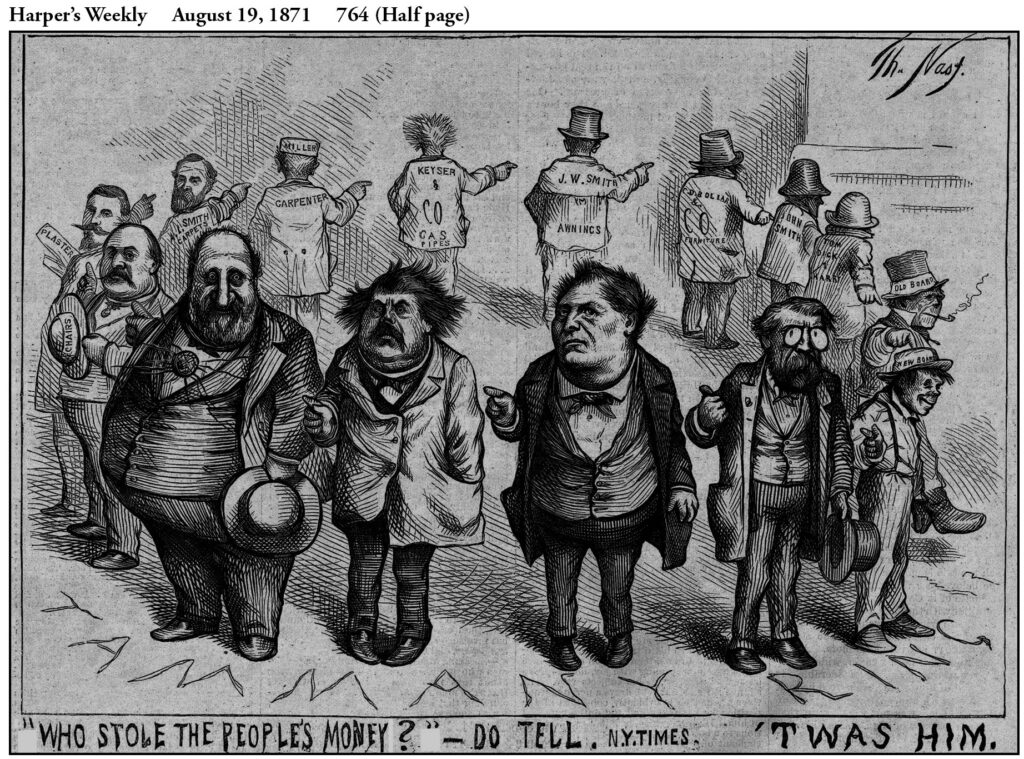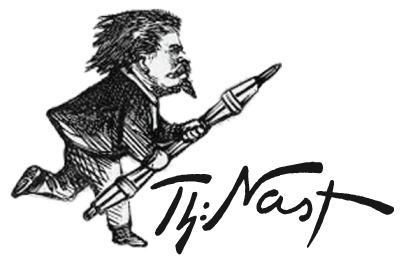
Harper’s Weekly – August 19, 1871
The “Big Four” Ring members — Bill Tweed, Peter Sweeny, Oakey Hall and Richard Connolly — all belonged to Tammany, with Tweed as Grand Sachem (chief) from 1863 until his downfall in late 1871. Dignified John Hoffman served as frontman, first as Mayor and then as Governor.
Tweed confessed shortly before he died in prison in 1878. Asked to define “Ring,” he responded: “A combination of men to do any improper thing.” Nast often used “Tammany” and “the Ring” interchangeably.
Other crooked Tammany/Ring members included judges, law enforcement officers, city contractors, auditors, book-keepers, and token Republicans. They milked the city for somewhere between $30 and $200 million. (Perhaps as much as $4 billion in today’s dollars).
The Ring had multiple income sources, almost all of them illegitimate. While taxes were the most prominent, bond issues were important and kickbacks from employees played a role. (Even a poor teacher had to pay $75 of her $300 annual salary to keep her job.)
The suggested kickbacks from the inflated invoices were 65% in 1870, up from 10% three years earlier. They were apportioned 25% to Tweed; 20% to Connolly; 10% to Sweeny; 5% to Hall; and 5% split between County Auditor James Watson and Board clerk Elbert Woodward who prepared the bills and presented them to Connolly for payment. Hall provided a second signature on the payment vouchers.
Many of the inflated invoices were for the new courthouse, finally completed for about $13,000,000, more than 50 times the original budget. Others covered fictitious repairs, supplies and rents. Edward Jones, who had the city’s stationery contract, charged over $1,000,000 annually; his bills included jewelry and household furnishings selected by Ring members from a nearby luxury store.
The invoices were mostly funneled through three bagmen. John Keyser, a plumbing contractor was paid $2,000,000; Andrew Garvey, known as the “Prince of Plasterers,” collected $3,000,000; and James “Chairs” Ingersoll, whose father Lorin once employed Tweed, had $5,000,000 pass through his hands. They also served as front men for other contractors’ illegal bills.
A whistle-blower, who tried and failed to extort money from Tweed, turned over financial records to the Times, which splashed them across its front page on July 22, 1871. Nast followed up with two half-page cartoons drawn on the same block as Two Great Questions. In the second one — Who Stole the People’s Money? — Tweed pointed to bag man Ingersoll, in accord with the “‘Twas Him” response. Nast’s circle of accusers, cast as the Tammany Ring, were labeled with their specialties; Chairs, Plaster, Carpets; Carpenter, Gas Pipes, Awnings, Furniture, Old Board, and New Board. One character labeled “Tom, Dick and Harry” suggested that anyone who was willing to pay for a piece of the public pie could have a slice.
For Tweed, Two Great Questions was the final straw. It supposedly spurred his classic comment: “Let’s stop them damned pictures. I don’t care so much what the papers write about me — my constituents can’t read; but damn it, they can see pictures.”
